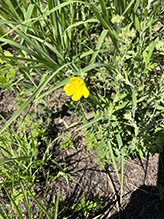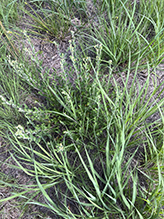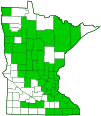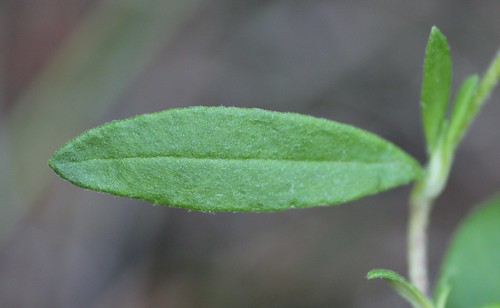hoary frostweed
(Crocanthemum bicknellii)
Conservation • Description • Habitat • Ecology • Use • Distribution • Taxonomy
Conservation Status |
|
|||||||
| IUCN Red List | not listed |
|||||||
| NatureServe | N5? - Secure SNR - Unranked |
|||||||
| Minnesota | not listed |
|||||||
Description |
||
Hoary frostweed is a hairy, fire tolerant, early summer wildflower of open places. It occurs in the United States from Maine to Maryland, west to South Dakota and Colorado, with just a handful of records further south, and in southern Ontario and Manitoba Canada. It is common in Minnesota. It is found in prairies, old fields, upland woodland openings, and roadsides. It grows under full sun in dry, usually sandy soil. Hoary frostweed is an erect perennial forb that rises on a cluster of stems from a persistent woody base (caudex). It can be 4¾″ to 27½″ (12 to 70 cm) tall but is usually 8″ to 20″ (20 to 50 cm) in height. The stems are loosely ascending to erect and are covered with short, soft, star-shaped (stellate) hairs. They are unbranched or sparingly branched at first flowering time. All stems are flowering stems and do not survive the winter. No basal overwintering stems are produced. The leaves are alternate, ¾″ to 1¼″ (18 to 32 mm) long, and ⅛″ to ¼″ (4 to 7 mm) wide, sometimes a little larger. They are on 1⁄32″ to ⅛″ (1 to 4 mm) long leaf stalks. The leaf blades are narrowly oval and widest in the middle (elliptic) to inversely lance-shaped. There is one main vein and several pairs of lateral veins (pinnately veined). Only the main vein (midrib) is visible on the upper surface. The lateral veins are raised on the lower surface. The upper surface is green and sparsely to moderately covered with stellate hairs. The lower surface is completely obscured by a dense covering of stellate hairs. The margins are untoothed. Two types of flowers are produced: open, cross-pollinated (chasmogamous) flowers are produced in the spring; and closed, self-fertilizing (cleistogamous) flowers are produced in the summer. The first inflorescence is a branched, flat-topped cluster (cyme) of 6 to 10 or more showy flowers at the end of each stem. Only one or two flowers are open at any time. Each flower is ⅝″ to 1″ (17 to 25 mm) wide. There are 5 outer floral leaves (sepals), 5 petals, 18 to 38 stamens, and 1 style. The sepals are arranged in two series. The outer two sepals are linear, ⅛″ to 5⁄16″ (3.5 to 8.0 mm) long, 1 ⁄64″ to 1⁄32″ (0.4 to 1.0 mm) wide, and sharply pointed at the tip. They are as long or almost as long as the inner sepals. The inner 3 sepals are egg-shaped elliptic, 3⁄16″ to 5⁄16″ (5 to 8 mm) long, 1 ⁄64″ to 1⁄32″ (0.4 to 1.0 mm) wide, and sharply pointed at the tip. The petals are yellow, hairless, inversely egg-shaped, 5⁄16″ to ½″ (8 to 12 mm) long, and 3⁄16″ to ⅜″ (5 to 10 mm) wide. The petals wither and drop soon after the flowers open. The style is short and has a cap-like stigma. The second inflorescence happens 1 to 3 months after the first and produces only cleistogamous flowers. New short branches, themselves unbranched, are produced with tight clusters (glomerules) of 1 to 10 flowers. There are 5 sepals and no petals. The outer two sepals are linear, 1 ⁄64″ to 1⁄16″ (0.5 to 1.5 mm) long, 1 ⁄64″ (0.3 mm) wide, and sharply pointed at the tip. The inner 3 sepals are egg-shaped elliptic, 1⁄16″ (1.5 to 2.2 mm) long, 1 ⁄32″ to 1⁄16″ (1.2 to 2.2 mm) wide, and sharply pointed at the tip. All of the sepals on both types of flowers are covered with only stellate hairs – there are no longer unbranched hairs. The fruit is a hairless, egg-shaped to ellipse-shaped capsule. The capsule developing from a chasmogamous flower is ⅛″ to ¼″ (3.5 to 5.5 mm) long and contains 12 or more seeds. The capsule developing from a chasmogamous flower is 1⁄16″ to ⅛″ (1.5 to 2.5 mm) long and contains just 1 to 3 seeds. |
||
Height |
||
4¾″ to 27½″ (12 to 70 cm) |
||
Flower Color |
||
Yellow |
||
Similar Species |
||
Canada frostweed (Crocanthemum canadense) is much less common in Minnesota. It usually has just a single chasmogamous flower, rarely 2, at the end of the stem. Sepals of the chasmogamous flowers have both stellate hairs and longer unbranched hairs. Outer sepals of the cleistogamous flowers are smaller, 1 ⁄64″ (0.2–0.5 mm.) long. The capsule developing from a chasmogamous flower contains just 5 to 12 seeds. |
||
Habitat |
||
Dry. Prairies, old fields, upland woodland openings, and roadsides. Full sun. Sandy soil. |
||
Ecology |
||
Flowering |
||
June to July |
||
Pests and Diseases |
||
|
||
Use |
||
|
||
Distribution |
||||
|
Sources |
|||
| 9/16/2022 | ||||
Nativity |
||||
Native |
||||
Occurrence |
||||
|
||||
Taxonomy |
|||
| Kingdom | Plantae (Plants) | ||
| Subkingdom | Pteridobiotina | ||
| Phylum | Tracheophyta (Vascular Plants) | ||
| Class | Magnoliopsida (Dicots) | ||
Order |
Malvales (mallows, rock-roses, and allies) | ||
Family |
Cistaceae (rock rose) | ||
Genus |
Crocanthemum (frostweeds) | ||
This species was originally classified as Helianthemum bicknellii. In 1836 New World species of Helianthemum were split into the separate genus Crocanthemum, but this was not widely accepted. Recent phylogenetic studies showed that the genus Helianthemum includes species with similar characteristics but that did not share a common ancestor (polyphyletic). In 2009 the genus Crocanthemum was resurrected to contain New World Species of Helianthemum. |
|||
Subordinate Taxa |
|||
|
|||
Synonyms |
|||
Crocanthemum majus Halimium majus Helianthemum bicknellii Helianthemum canadense var. walkerae |
|||
Common Names |
|||
Bicknell’s hoary frostweed Bicknell’s rock-rose hoary frostweed hoary rock-rose plains frostweed plains sun-rose rock-rose |
|||
Glossary
Caudex
A short, thickened, woody, persistent enlargement of the stem, at or below ground level, used for water storage.
Cleistogamous
Automatically self-pollinating. Refers to bud-like flowers that do not open but automatically self-pollinate, or to plants with such flowers.
Cyme
A branched, flat-topped or convex flower cluster in which the terminal flower opens first and the outermost flowers open last.
Elliptic
Narrowly oval, broadest at the middle, narrower at both ends, with the ends being equal.
Glomerule
A dense, cluster; a small, compact, head-like cyme.
Linear
Long, straight, and narrow, with more or less parallel sides, like a blade of grass.
Pinnately veined
With the veins arranged like the vanes of a feather; a single prominent midvein extending from the base to the tip and lateral veins originating from several points on each side.
Sepal
An outer floral leaf, usually green but sometimes colored, at the base of a flower.
Stellate
Star-shaped. Stellate hairs have several or many branches radiating from the base.
Visitor Photos |
|||||
Share your photo of this plant. |
|||||
| This button not working for you? Simply email us at info@MinnesotaSeasons.com. Attach one or more photos and, if you like, a caption. |
|||||
Nancy Falkum |
|||||
Crocanthemum Bicknellii Hoary frost weed at TNC Cox Unit |
|||||
 |
 |
||||
Crocanthemum Bicknellii Hoary frost weed? |
|||||
 |
|||||
MinnesotaSeasons.com Photos |
|||||
|
|||||

Visitor Videos |
|||
Share your video of this plant. |
|||
| This button not working for you? Simply email us at info@MinnesotaSeasons.com. Attach a video, a YouTube link, or a cloud storage link. |
|||
Other Videos |
|||

Visitor Sightings |
|||||
Report a sighting of this plant. |
|||||
| This button not working for you? Simply email us at info@MinnesotaSeasons.com. Be sure to include a location. |
|||||
| Nancy Falkum 6/26/2022 |
Location: Weaver Dunes Preserve, Cox Unit Crocanthemum Bicknellii Hoary frost weed? |
||||
| Nancy Falkum 6/17/2022 |
Location: Weaver Dunes Preserve, Cox Unit Crocanthemum Bicknellii Hoary frost weed at TNC Cox Unit |
||||
MinnesotaSeasons.com Sightings |
|||||

Created: 9/17/2022
Last Updated:




